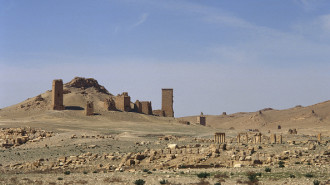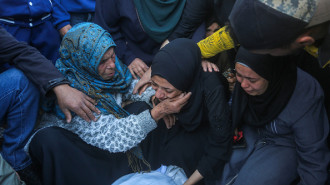Gaza health ministry releases detailed list of nearly 7,000 Palestinians killed, following US accusations
The Palestinian health ministry in Gaza has released the names of almost 7,000 Gazans killed so far by Israeli strikes since 7 October, a day after US President Joe Biden tried to cast doubt on the toll figures.
The health ministry says at least 7,028 people were killed in Gaza since Israel's bombing campaign on the besieged strip began two weeks ago.
The released list contains the names of 6,747 victims, including their gender, age and identity card number.
It also highlighted that 281 bodies had not yet been identified.
The ministry said in a statement that the United States had "brazenly cast doubt on the truth of the announced toll".
"We have decided to announce the details of the names to the whole world so that the truth is known about the genocide perpetrated by the Israeli occupation against our people."
US President Joe Biden said on Wednesday that he had "no confidence" in the Palestinian health ministry's death toll figures.
"What they say to me is I have no notion that the Palestinians are telling the truth about how many people are killed. I'm sure innocents have been killed, and it's the price of waging a war," Biden told a White House press conference.
Israel has completely blocked Gaza's borders, barring foreign journalists and humanitarian workers from entering.
The United Nations and other international institutions and experts, as well as the Fatah-led Palestinian Authority in the West Bank - rivals of Hamas - say the Gaza health ministry has long made a good-faith effort to account for the dead under the most difficult conditions.
The ministry is made up of non-partisan civil servants and health professionals and its staff are employed by the Ramallah-based Palestinian Authority.
Despite this, Western media organisations have often described it as "Hamas-linked" since Hamas's surprise attack on Israel on October 7 and Israel's subsequent indiscriminate retaliation against Gaza.
"The numbers may not be perfectly accurate on a minute-to-minute basis," said Michael Ryan, of the World Health Organization’s Health Emergencies Program. "But they largely reflect the level of death and injury."
In previous wars, the ministry's counts have held up to UN scrutiny, independent investigations and even Israel's tallies.
How does Gaza's health ministry collect data?
Gaza's most widely quoted source on casualties is Health Ministry spokesperson Ashraf al-Qidra. From an office at Shifa Hospital in Gaza City, al-Qidra receives a constant flow of data from every hospital in the strip.
Hospital administrators say they keep records of every wounded person occupying a bed and every dead body arriving at a morgue.
They enter this data into a computerised system shared with al-Qidra and colleagues. According to screenshots hospital directors sent to AP, the system looks like a colour-coded spreadsheet divided into categories: name, ID number, date of hospital entry, type of injury, and condition.
Names aren't always available, al-Qidra said. He and colleagues face disruptions because of spotty connectivity but say they call to double-check the numbers.
"Every person entering our hospital is recorded," said Atef Alkahlout, director of Gaza's Indonesian Hospital. "That’s a priority."
The ministry releases casualty updates every few hours, providing the number of dead and wounded with a breakdown for men, women and children.
The ministry collects data from other sources, too, including the Palestinian Red Crescent.
Throughout the recent four wars Israel launched on the Gaza Strip, UN agencies have cited the Gaza's health ministry's death tolls in regular reports.
The International Committee of the Red Cross and Palestinian Red Crescent also use the numbers.
In the aftermath of war, the UN humanitarian office would publish final death tolls based on its own research into medical records.
In all cases, the UN's counts have largely been consistent with the Gaza health ministry's.
Agencies contributed to this report.




 Follow the Middle East's top stories in English at The New Arab on Google News
Follow the Middle East's top stories in English at The New Arab on Google News

![A group of Palestinians, foreign and Israeli activists gather to participated in an olive picking event on the land in the town of Battir, which is under threat of confiscation by Israel in Bethlehem, occupied West Bank on 8 November 2024. [Getty]](/sites/default/files/styles/image_330x185/public/2182930803.jpeg?h=199d8c1f&itok=__0LgGsa)
